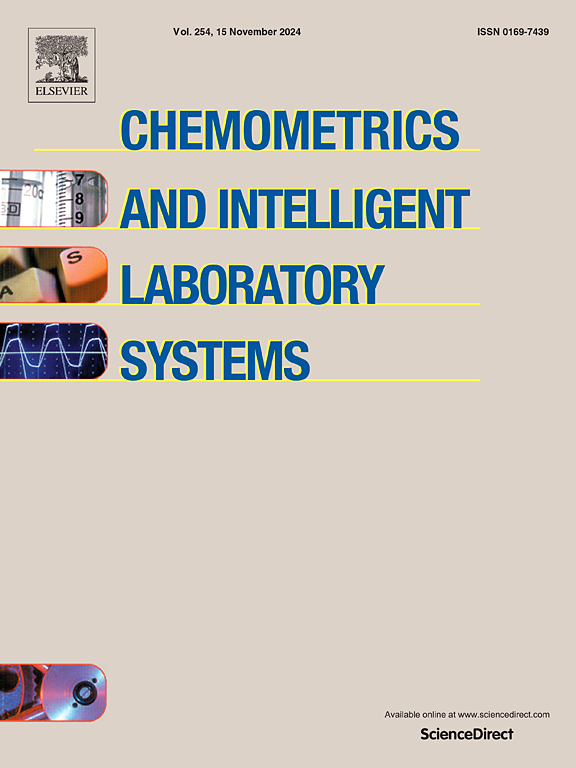A multi-output hybrid prediction model for key indicators of wastewater treatment processes
IF 3.7
2区 化学
Q2 AUTOMATION & CONTROL SYSTEMS
Chemometrics and Intelligent Laboratory Systems
Pub Date : 2025-01-17
DOI:10.1016/j.chemolab.2025.105316
引用次数: 0
Abstract
The fluctuating working conditions in wastewater treatment processes, influenced by various factors, result in highly nonlinear characteristics in online monitoring data. This presents challenges for accurately estimating water quality. Addressing the issue of single-model performance degradation under changing data distributions, this paper proposes a two-stage hybrid prediction scheme based on clustering. Firstly, historical data is divided and features are extracted and clustered based on different time periods. Subsequently, distinct prediction models are applied to data within each working mode, thereby enhancing overall prediction performance. The selection and combination of two classical models with different characteristics, namely the partial least squares random weight neural network (PLS-RWNN) and the multi-output correlation vector machine (MRVM), enable better adaptation to the complex wastewater treatment data source. The proposed approach is validated using the wastewater treatment platform BSM2. On average, clustering modeling combined with models provides better predictions for all three variables. The comprehensive index RMSSD of the mixed model is 0.6189, which is 42.17 % higher than that of a single model used before clustering. Results indicate that the proposed network architecture significantly improves prediction performance, highlighting its effectiveness in dealing with the nonlinear and fluctuating nature of wastewater treatment data.
污水处理过程关键指标的多输出混合预测模型
污水处理过程中工作条件的波动,受各种因素的影响,导致在线监测数据具有高度非线性特征。这对准确估计水质提出了挑战。针对单模型在数据分布变化下性能下降的问题,提出了一种基于聚类的两阶段混合预测方案。首先,对历史数据进行分割,根据不同的时间段提取特征并聚类;随后,对不同工作模式下的数据应用不同的预测模型,从而提高整体预测性能。偏最小二乘随机加权神经网络(PLS-RWNN)和多输出相关向量机(MRVM)这两种具有不同特征的经典模型的选择和组合,能够更好地适应复杂的污水处理数据源。采用污水处理平台BSM2对该方法进行了验证。平均而言,与模型相结合的聚类建模为所有三个变量提供了更好的预测。混合模型的综合指标RMSSD为0.6189,比聚类前使用的单一模型的RMSSD高42.17%。结果表明,所提出的网络结构显著提高了预测性能,突出了其在处理废水处理数据的非线性和波动性方面的有效性。
本文章由计算机程序翻译,如有差异,请以英文原文为准。
求助全文
约1分钟内获得全文
求助全文
来源期刊
CiteScore
7.50
自引率
7.70%
发文量
169
审稿时长
3.4 months
期刊介绍:
Chemometrics and Intelligent Laboratory Systems publishes original research papers, short communications, reviews, tutorials and Original Software Publications reporting on development of novel statistical, mathematical, or computer techniques in Chemistry and related disciplines.
Chemometrics is the chemical discipline that uses mathematical and statistical methods to design or select optimal procedures and experiments, and to provide maximum chemical information by analysing chemical data.
The journal deals with the following topics:
1) Development of new statistical, mathematical and chemometrical methods for Chemistry and related fields (Environmental Chemistry, Biochemistry, Toxicology, System Biology, -Omics, etc.)
2) Novel applications of chemometrics to all branches of Chemistry and related fields (typical domains of interest are: process data analysis, experimental design, data mining, signal processing, supervised modelling, decision making, robust statistics, mixture analysis, multivariate calibration etc.) Routine applications of established chemometrical techniques will not be considered.
3) Development of new software that provides novel tools or truly advances the use of chemometrical methods.
4) Well characterized data sets to test performance for the new methods and software.
The journal complies with International Committee of Medical Journal Editors'' Uniform requirements for manuscripts.

 求助内容:
求助内容: 应助结果提醒方式:
应助结果提醒方式:


